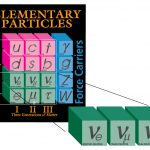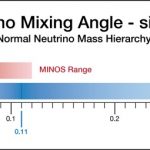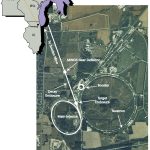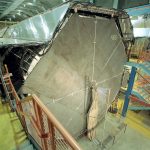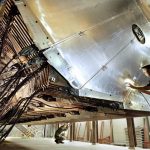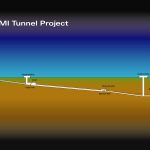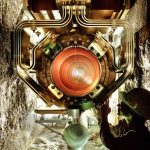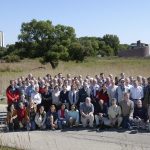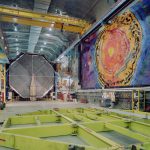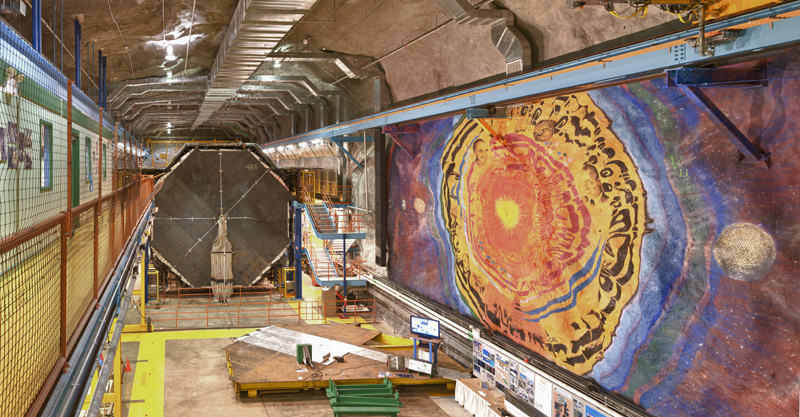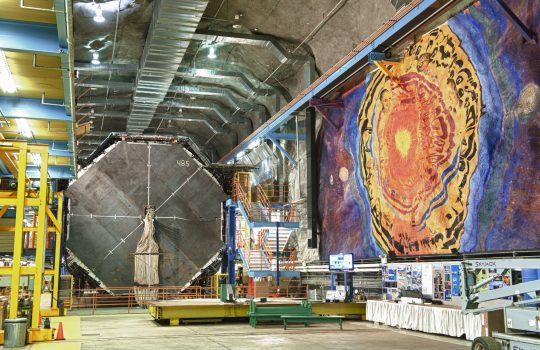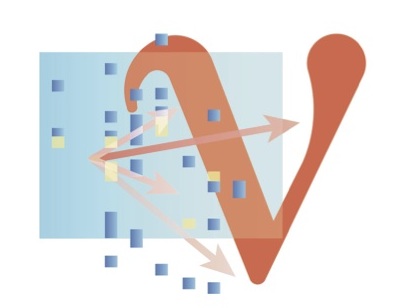Scientists of the MINOS experiment at the Department of Energy’s Fermi National Accelerator Laboratory announced today (June 24) the results from a search for a rare phenomenon, the transformation of muon neutrinos into electron neutrinos. The result is consistent with and significantly constrains a measurement reported 10 days ago by the Japanese T2K experiment, which announced an indication of this type of transformation.
The results of these two experiments could have implications for our understanding of the role that neutrinos may have played in the evolution of the universe. If muon neutrinos transform into electron neutrinos, neutrinos could be the reason that the big bang produced more matter than antimatter, leading to the universe as it exists today.
The Main Injector Neutrino Oscillation Search (MINOS) at Fermilab recorded a total of 62 electron neutrino-like events. If muon neutrinos do not transform into electron neutrinos, then MINOS should have seen only 49 events. The experiment should have seen 71 events if neutrinos transform as often as suggested by recent results from the Tokai-to-Kamioka (T2K) experiment in Japan. The two experiments use different methods and analysis techniques to look for this rare transformation.
To measure the transformation of muon neutrinos into other neutrinos, the MINOS experiment sends a muon neutrino beam 450 miles (735 kilometers) through the earth from the Main Injector accelerator at Fermilab to a 5,000-ton neutrino detector, located half a mile underground in the Soudan Underground Laboratory in northern Minnesota. The experiment uses two almost identical detectors: the detector at Fermilab is used to check the purity of the muon neutrino beam, and the detector at Soudan looks for electron and muon neutrinos. The neutrinos’ trip from Fermilab to Soudan takes about one four hundredths of a second, giving the neutrinos enough time to change their identities.
For more than a decade, scientists have seen evidence that the three known types of neutrinos can morph into each other. Experiments have found that muon neutrinos disappear, with some of the best measurements provided by the MINOS experiment. Scientists think that a large fraction of these muon neutrinos transform into tau neutrinos, which so far have been very hard to detect, and they suspect that a tiny fraction transform into electron neutrinos.
The observation of electron neutrino-like events in the detector in Soudan allows MINOS scientists to extract information about a quantity called sin2 2θ13 (pronounced sine squared two theta one three). If muon neutrinos don’t transform into electron neutrinos, this quantity is zero. The range allowed by the latest MINOS measurement overlaps with but is narrower than the T2K range. MINOS constrains this quantity to a range between 0 and 0.12, improving on results it obtained with smaller data sets in 2009 and 2010. The T2K range for sin2 2θ13 is between 0.03 and 0.28.
“MINOS is expected to be more sensitive to the transformation with the amount of data that both experiments have,” said Fermilab physicist Robert Plunkett, co-spokesperson for the MINOS experiment. “It seems that nature has chosen a value for sin2 2θ13 that likely is in the lower part of the T2K allowed range. More work and more data are really needed to confirm both these measurements.”
The MINOS measurement is the latest step in a worldwide effort to learn more about neutrinos. MINOS will continue to collect data until February 2012. The T2K experiment was interrupted in March when the severe earth quake in Japan damaged the muon neutrino source for T2K. Scientists expect to resume operations of the experiment at the end of the year. Three nuclear-reactor based neutrino experiments, which use different techniques to measure sin2 2θ13, are in the process of starting up.
“Science usually proceeds in small steps rather than sudden, big discoveries, and this certainly has been true for neutrino research,” said Jenny Thomas from University College London, co-spokesperson for the MINOS experiment. “If the transformation from muon neutrinos to electron neutrinos occurs at a large enough rate, future experiments should find out whether nature has given us two light neutrinos and one heavy neutrino, or vice versa. This is really the next big thing in neutrino physics.”
The MINOS experiment involves more than 140 scientists, engineers, technical specialists and students from 30 institutions, including universities and national laboratories, in five countries: Brazil, Greece, Poland, the United Kingdom and the United States. Funding comes from: the Department of Energy Office of Science and the National Science Foundation in the U.S., the Science and Technology Facilities Council in the U.K; the University of Minnesota in the U.S.; the University of Athens in Greece; and Brazil’s Foundation for Research Support of the State of São Paulo (FAPESP) and National Council of Scientific and Technological Development (CNPq).
Fermilab is a national laboratory supported by the Office of Science of the U.S. Department of Energy, operated under contract by Fermi Research Alliance, LLC.
For more information about MINOS and related experiments, visit the Fermilab neutrino website:
http://www.fnal.gov/pub/science/experiments/intensity/
- The building blocks of matter include three types of neutrinos, known as electron neutrino, muon neutrino and tau neutrino. For more than a decade, physicists have seen evidence that these neutrinos can transform into each other.
- The observation of electron neutrino-like events allows MINOS scientists to extract information about a quantity called sin22θ13. If muon neutrinos don’t transform into electron neutrinos, sin22θ13 is zero. The new MINOS result constrains this quantity to a range between 0 and 0.12, improving on results it obtained with smaller data sets in 2009 and 2010. The MINOS range is consistent with the T2K range for sin22θ13, which is between 0.03 and 0.28. According to the T2K data, the most likely value is 0.11. The MINOS result prefers a value of 0.04, and its data indicates that sin22θ13 is non-zero at the 89% confidence level.
- Neutrinos, ghost-like particles that rarely interact with matter, travel 450 miles straight through the earth from Fermilab to Soudan — no tunnel needed. The Main Injector Neutrino Oscillation Search (MINOS) experiment studies the neutrino beam using two detectors. The MINOS near detector, located at Fermilab, records the composition of the neutrino beam as it leaves the Fermilab site. The MINOS far detector, located in Minnesota, half a mile underground, again analyzes the neutrino beam. This allows scientists to directly study the oscillation of muon neutrinos into electron neutrinos or tau neutrinos under laboratory conditions.
- The MINOS far detector is located in a cavern half a mile underground in the Soudan Underground Laboratory, Minnesota. The 100-foot-long MINOS far detector consists of 486 massive octagonal planes, lined up like the slices of a loaf of bread. Each plane consists of a sheet of steel about 25 feet high and one inch thick, with the last one visible in the photo. The whole detector weighs 6,000 tons. Since March 2005, the far detector has recorded neutrinos from a beam produced at Fermilab. The MINOS collaboration records about 1,000 neutrinos per year.
- The 1,000-ton MINOS near detector sits 350 feet underground at Fermilab. The detector consists of 282 octagonal-shaped detector planes, each weighing more than a pickup truck. Scientists use the near detector to verify the intensity and purity of the muon neutrino beam leaving the Fermilab site. Photo: Peter Ginter
- Fermilab completed the construction and testing of the Neutrino at the Main Injector (NuMI) beam line in early 2005. Protons from Fermilab’s Main Injector accelerator (left) travel 1,000 feet down the beam line, smash into a graphite target and create muon neutrinos. The neutrinos traverse the MINOS near detector, located at the far end of the NuMI complex, and travel straight through the earth to a former iron mine in Soudan, Minnesota, where they cross the MINOS far detector. Some of the neutrinos arrive as electron neutrinos or tau neutrinos.
- When operating at highest intensity, the NuMI beam line transports a package of 35,000 billion protons every two seconds to a graphite target. The target converts the protons into bursts of particles with exotic names such as kaons and pions. Like a beam of light emerging from a flashlight, the particles form a wide cone when leaving the target. A set of two special lenses, called horns (photo), is the key instrument to focus the beam and send it in the right direction. The beam particles decay and produce muon neutrinos, which travel in the same direction. Photo: Peter Ginter
- More than 140 scientists, engineers, technical specialists and students from Brazil, Greece, Poland, the United Kingdom and the United States are involved in the MINOS experiment. This photo shows some of them posing for a group photo at Fermilab, with the 16-story Wilson Hall and the spiral-shaped MINOS service building in the background.
- Far view The University of Minnesota Foundation commissioned a mural for the MINOS cavern at the Soudan Underground Laboratory, painted onto the rock wall, 59 feet wide by 25 feet high. The mural contains images of scientists such as Enrico Fermi and Wolfgang Pauli, Wilson Hall at Fermilab, George Shultz, a key figure in the history of Minnesota mining, and some surprises. A description of the mural, painted by Minneapolis artist Joe Giannetti, is available here.

